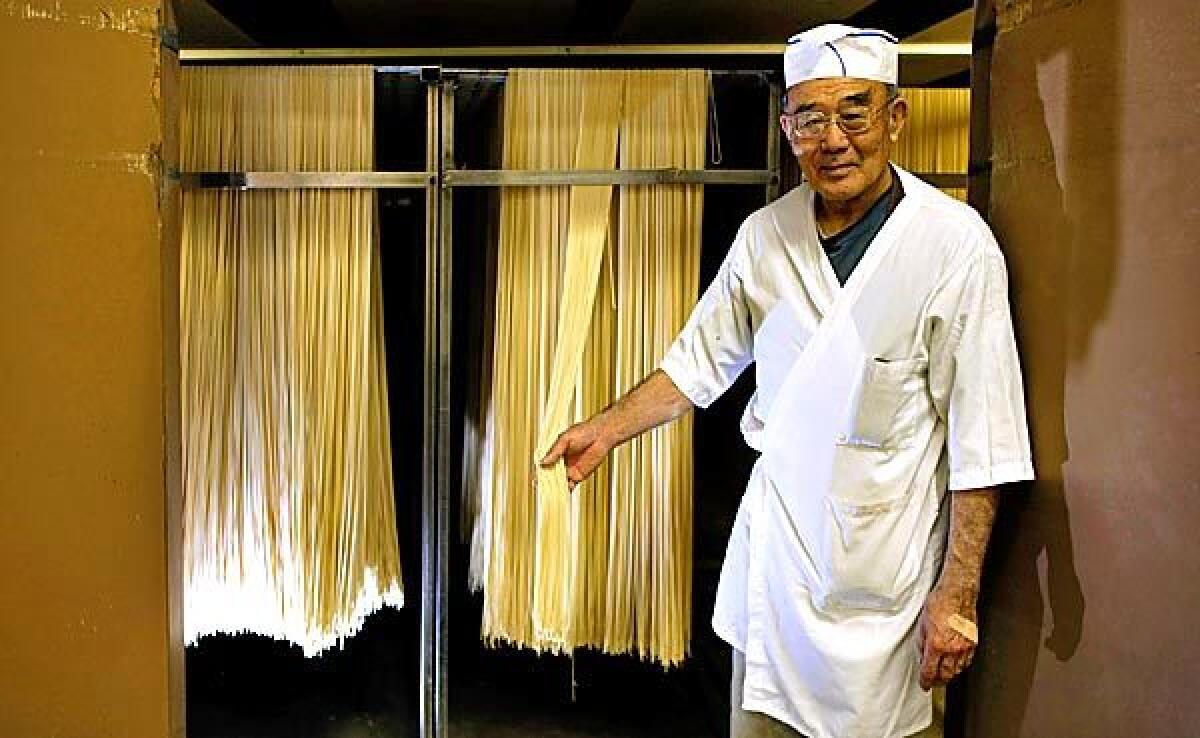The Artisan: Local noodle maker on the cutting edge of technology

- Share via
As Shoichi Sayano pulls open the metal drying-room door, a breeze sends ripples down the curtain-like wall of 10-foot-long udon noodles neatly folded over metal drying racks. “I still cut the noodles every day,” says the 75-year-old former aerothermodynamics engineer who took over his father’s noodle-making duties at Nanka Seimen more than 30 years ago.
Little has changed in the flour-dusted drying room since the Japanese noodle factory’s founder, Masakichi Tokunaga, handed the front door keys to Sayano’s father — an employee at Nanka Seimen during World War II. Elsewhere in the Vernon-based factory, that powdery residue covers state-of-the-art Japanese noodle and wonton manufacturing equipment.
Embracing manufacturing innovations has proved essential during Nanka Seimen’s expansion from a mom-and-pop noodle shop to a bustling factory producing thousands of pounds of soba (buckwheat) and somen (thin wheat) noodles daily. But ultimately, it is a steadfast commitment to family that has afforded the shop its more than 100-years-strong local presence.
Sayano learned to appreciate the ins and outs of operating a large noodle factory while playing hide and seek among curtains of hand-cut noodles.
“Before this machine, my father developed a cutter that put the wonton sheets through air pressure and cut them in a grid pattern,” he says, pointing to a wonton-cutting device he installed several years ago. And “before that, you had to put [the dough] on a table and cut it by hand.”
For the former McDonnell Douglas engineer, the challenge of making noodles in mass quantities wasn’t exactly on par with aerospace design. But a commitment to kazoku (the Japanese word for family) would eventually lure Sayano back to the business of kishimen (linguini-like flat wheat noodles).
“My father was getting old, so I came to help him.”
Those family ties are why Sayano’s father, Keiichiro, wound up in Los Angeles in the late 1930s.
Keiichiro had followed his father (Sayano’s grandfather) to L.A. from Japan and started working at Nanka Seimen to help pay off a family debt.
According to Sayano, Nanka Seimen’s original owner made his first batch of udon on the most technologically advanced noodle-making equipment available in 1905.
“At the time, machinery was a new way to make noodles, so he was probably one of the first [in the United States] to have it,” says Sayano of the rudimentary hand-cranked machine that Tokunaga imported from his hometown of Saga, Japan, a prefecture on the island of Kyushu. Tokunaga’s wife owned a restaurant in Little Tokyo. “It took too much time to knead the noodles by hand.”
At the tightknit factory, employees and their families, including the Sayanos, lived on the second floor of the building.
Shortly after the bombing of Pearl Harbor on Dec. 7, 1941, Tokunaga handed Keiichiro the keys to the factory.
“The owners were old and figured they couldn’t take the harsh life of the [internment] camp, so they left quickly,” recalls Sayano, who was 7 years old when the Tokunagas fled east to avoid mandatory Japanese American citizen evacuation in California. “You only had a very short time to leave everything and get out or go to the camps.
“My father stayed behind to pack up the machinery — we were one of the last to leave for the Arizona camps,” he says.
Four years later, the Sayanos returned to Los Angeles expecting a life free of flour dust. “My father didn’t plan on reopening the noodle factory … but it wasn’t easy at that time for Japanese people trying to reestablish their lives.”
After pulling the machinery out of storage, his father focused on new products to stay afloat. The company now produces more than 10,000 pounds of wonton wrappers and noodles a day, including several varieties of Japanese noodles (soba, kishimen, somen and udon noodles of varying thicknesses) as well as Chinese egg noodles.
Keeping up with technological advancements in noodle-making machinery has been second nature to the engineer. “No waste,” says Sayano, lifting the lid off a plastic bin filled with dried noodle scraps that will be ground with the fresh noodle dough the following day. “Before the machines, you had to soak the scraps overnight to reuse them.”
By early afternoon, the hum of the noodle machines has been replaced by a repetitive mechanical punching sound. Sayano’s wife, Nobuko, is supervising a half-dozen employees flipping through the pre-cut stacks of wonton wrappers made that morning.
“The [packaging] technology was mainly for meat and cheese before, but for something like wontons, you can’t just vacuum seal,” says Sayano, intent on relaying precisely how the oxygen must be replaced with nitrogen to keep the sheets from forming a brick-like block.
But even with one ear always tuned to noodle-making technology, Sayano says one thing is still as it always has been. “The recipes don’t ever change.”
More to Read
Eat your way across L.A.
Get our weekly Tasting Notes newsletter for reviews, news and more.
You may occasionally receive promotional content from the Los Angeles Times.










